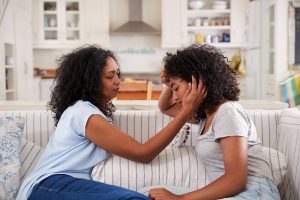
Published By: The Tapping Solution
Written By: Nick Ortner
One of the central tenets of trauma relief work is understanding how quickly trauma can spread. While those at the center of a trauma may be most severely affected, the larger community typically also suffers from trauma symptoms that are more subtle and harder to detect.
Keenly aware of how this phenomenon had been playing out in Newtown, CT since the Sandy Hook Elementary School shooting took place in December 2012, The Tapping Solution Foundation recently offered a parents’ workshop to the larger community.
The group that came together during this workshop was comprised of eleven moms. None of these women knew each other, and none had lost children or been physically present during the shootings. Yet all of them had spent the past two years living in a hyper vigilant state, wracked by intense fear, anxiety, and survivor’s guilt.
For nearly two years all of these women had felt responsible for the lives of their children, husbands, friends and community. They expressed the incredible overwhelm they had all felt, as well as the guilt they had felt for feeling overwhelmed. They were, after all, the lucky ones, the ones whose families were still intact. Who were they to buckle under a trauma that had affected other families so much more deeply than their own?
One by one, they each expressed that they felt they couldn’t let their guards down, because if they did, they would fall apart. If that happened, who would take care of everyone they’d been caring for?
As each parent voiced how she was feeling, Lori Leyden, Director of The Tapping Solution Foundation, asked if anyone else was feeling that particular way. Each time, hands around the room shot up. After explaining that these are all common experiences in trauma survivors, the group began tapping together.
Through tapping, they began to reconnect with their bodies, and then release the incredible fear, anxiety and guilt they had been feeling for the previous two years. Finally, they could feel safe in their own bodies again, and let go of the need to try to control everything inside and around them. Instead of trying to survive alone, they could come together and support each other in healing and moving their lives and the entire community forward.
“As each person voiced their own truth,” Lori explained, “they experienced a deep sense of connection with everyone in that room, and realized they weren’t alone at all. And that in itself is another miracle.”
Trauma survivors often isolate themselves as a way of avoiding additional pain. While that isolation can serve a purpose by helping to keep ourselves and others safe, over time that isolation becomes an additional source of pain. That’s why it’s so important to join together with like-minded people and give a voice to what previously seemed unspeakable – our experience, emotions, and beliefs – to create a community that supports healthy emotional release and healing from trauma.
Facebook Comments
Blog Comments
Recent Blog Posts

Middle School Anxiety: From Overwhelm to Empowerment
Written by: Nick Ortner

Tapping into Your Child’s Depression: Shedding “The Blues”
Written by: Nick Ortner

